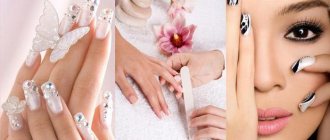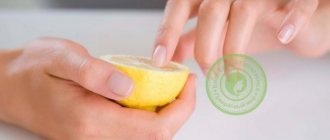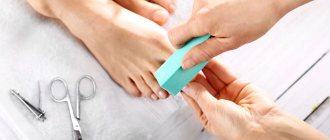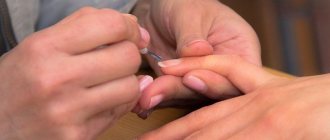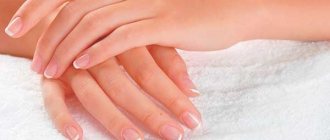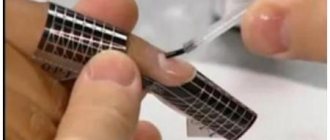A professional nail artist can create any desired shape and length of nails, a charming design, and transform your hands for the better.
But in order for the resulting effect to please you for as long as possible and not be accompanied by unpleasant sensations after the procedure, you need to know what to do after nail extensions. Then the transformation will not significantly affect the quality of your life or the performance of your usual activities. I’ll tell you about this today, and also give recommendations on special cases of solving problems that arose after the extension was completed.
Types of extensions and methods of artificial nail lengthening
Growing nails naturally is a long process and does not always lead to achieving the desired result.
There can be a variety of reasons for this:
loading…
- soft nail plate;
- dry fabric structure, which invariably leads to fragility;
- accidental loss of length during any activity;
- slow growth (it should be noted that this parameter is quite individual for each person);
- frequent contact with damaging factors associated with professional activities or other conditions;
- congenital structural features of the nail plate, which, when grown, give an irregular shape and curvature.
And beautiful nails are an integral and desirable part of the entire image of a well-groomed, beautiful woman.
Extensions effectively solve the problem of giving nails any shape and length. And, contrary to popular belief, a well-performed procedure should not result in health problems or cause irreparable harm to your nails.
Questions about how to make nails significantly longer, especially if they themselves grow poorly and slowly, have been dealt with in the world of beauty for a long time, developing various techniques.
Unfortunately, the use of false nails set with glue for these purposes, which initially appeared as a simple and sure-fire way to solve the problem, is not particularly practical: at any inopportune moment, the artificial plate can come off and get lost.
And wearing such nails on an everyday basis is extremely inconvenient; you have to be extremely careful in your movements and worry about the safety of the achieved effect. Therefore, the invention of nail extension techniques was an excellent alternative.
Nowadays, a wide variety of extension methods are used all over the world; I’ll briefly tell you about the main ones:
- Molded extensions on tips . It can be safely classified as a modernized version of false nails, since the tips are a ready-made nail template made of a special polymer, which is attached from the middle of a real plate with glue. Next, to level and give naturalness, the surface is coated with acrylic or gel and decorative varnish is applied. This method is characterized by a lower price, convenience, and ease of correction. However, significant disadvantages can be noted:
- it is difficult to give the most natural look to the nail;
- not suitable for incorrect plate growth;
- difficult to choose an individual size;
- shorter wearing period.
A significant advantage of the technique of using upper forms for extensions is, of course, the ability to perform work on a thin, weakened plate or if the nails are badly bitten.
- Modeling extension. With this type of extension, an artificial nail plate is formed using gel or acrylic according to a stencil placed under the nail. This is a rather labor-intensive and complex task, but the main positive effect is an absolutely harmonious, close to natural, nail shape, as well as the ability to correct pathological growth characteristics. This type of extension is characterized by long-term wear, ease of use with your fingers and quick adaptation to changes. The question of whether it is better to use acrylic or gel can be debated endlessly; each of these materials has pros and cons, so the question of personal preference still remains open here. Taking into account the disadvantages and advantages of each extension product, many nail technicians successfully use combined acrylic or acrygel (polygel). It does not have a too strong odor, like acrylic, and when it hardens, it is less elastic and soft than gel.
In addition to these basic extension methods, there are various nail extension techniques, such as fiberglass or fabric. They have their own characteristics in their work, but the base material for performing the technique will also be a gel extension kit.
The approach to choosing an extension method can be based solely on personal preferences, the desire to experiment, or dictated by circumstances - not every nail may be suitable for one or another method of artificial lengthening.
The durability of your nail extensions directly depends on the skill of the manicurist who performed the work and your compliance with the recommendations after the procedure. I'll tell you more about this.
Advice to the client about nail extensions
add article
For those who decided to get their nails done for the first time, you need to know some things. They will save your time and keep your nails in excellent condition as long as you wear them.
- Try not to grow long nails for the first time. They cannot be removed like false nails, the moment they get in the way and put on again, until the next visit to the master they will be part of your hands. You need to get used to them gradually. After some time, a couple of days or a week, you will no longer separate yourself and your hands with long nails
- Try to be careful in ordinary situations, for example, when opening the door of a refrigerator or car. Skill will be required when typing on a computer keyboard or using a telephone, and fastening buttons or zippers. Over time, this accuracy will be performed automatically, giving a certain character or even charm to your movements.
- When choosing a design or shape, describe in detail your wishes to the master, tell us what kind of work you often have to do with your hands, be sure to listen to his advice after he looks at your hands. He may recommend not the longest nails for the first extension, perhaps not the shape that you would like to get right away, but you will have to make a decision about what nails you will wear yourself
- Acrylic and gel nails can be removed by contacting a specialist; it is not that expensive, but it takes some time, from 30 minutes to an hour. You can do this even if you don’t plan to build them up, but walk around with your nails after removing them
- Never try to remove nails yourself. You can damage the area where the nail is formed, which can lead to very sad consequences. It may take a lot of effort and time to correct the situation. You may even have to wear extended nails for a long time in order to hide the defect.
- If natural nails grow in an irregular shape (flat, concave or very short), by extending artificial nails, you can straighten their shape and achieve the desired length. For many people, nail extensions help them get rid of bad nail habits and transform the appearance of their hands in one day.
- Do not tap the ends of your nails on hard surfaces, do not use your nails to open anything, do not squeeze or try to bend them. Modern materials with appropriate nail care do not have a negative effect. In addition, your fingers and nails are periodically examined by an experienced master, who can always tell you what to do so as not to harm your nails.
- It is not advisable for pregnant women to have artificial nails, or if you are taking hormonal medications or antibiotics.
The most common Rumors and Myths about nail extensions Myth 1. Nail extensions spoil your natural nails.
Reality: The materials used in extensions do not damage nails.
Both acrylic and gel are safe for natural nails. Nails are damaged by inexperienced, unskilled nail technicians by heavily filing the client’s natural nail. The clients themselves save money on removing and tearing off artificial nails from natural nails along with the top layer of the nail plate, disfiguring the cuticle area with files. While wearing artificial nails, natural nails are in a protected sealed state and are not subject to any aggressive external influences. In most cases, with constant wearing of extended nails, even a damaged natural nail acquires the correct direction of growth and shape, stops peeling and can completely acquire an aesthetic appearance. Extensions are also recommended for those who have a lot of stress on their nails. Myth 2. All masters are the same and do the work the same way and there is no difference where and to whom to go to get your nails done.
Reality: Nail extension is a procedure that requires constant improvement and training from the artist.
Diligence, but at first glance the procedure does not seem complicated. Good masters train for years. Pay attention to the availability of advanced training diplomas. Visiting expensive salons does not guarantee the quality of work. In a salon there is also a much greater chance of running into an amateur or a novice master than with a master at home. As a rule, novice masters go to the salon to work. And most importantly, there is no good nail technician who can do nail extensions for 3 kopecks. Myth 3. Is gel better than Acrylic or vice versa?
Reality: I wonder who started the rumor among the masses that gel is better than acrylic and does not damage the nail.
Acrylic and Gel belong to the same group of chemicals. Acrylates. Myth 4: Extended nails require frequent and difficult care.
Reality: Artificial nails require maintenance only once every 2-4 weeks (correction).
On extended nails, even the cheapest varnish lasts an average of 2 weeks. With artificial nails, you are much less likely to have to do a trimmed manicure with steaming. Dirt collects under such nails less often, and you can forget about hangnails altogether. Myth 5. You can’t fiddle around in water for a long time, do laundry, wash dishes or floors, etc.
Reality: All this can be done, many advise wearing gloves, and this will protect not only your nails, but also the skin of your hands from harmful caustic substances, but washing dishes and without gloves it does not cause much harm.
Myth 6. Natural nails do not breathe under acrylic/gel.
Reality: The very concept of “breathing” is no longer true.
Even an ordinary person who knows how to think logically will understand that this is not so. Nails are keratinized tissue that allows moisture, fat, etc. to pass through small pores. Nail nutrition occurs in the matrix, in the area under the cuticle, and through capillaries, so just use cuticle oil, drink vitamins and your nails will receive the necessary nutrition and be healthy ! Myth 7: Artificial nails break quickly.
Reality: In fact, extended nails are very strong and very difficult to break, provided, of course, high-quality materials and a good master.
Exceptions: excessive sweating of the hands, pregnancy, taking hormonal medications (including contraceptives). So if the material begins to peel off, crumble, or does not stick at all, look for a problem in the master or in your health. Myth 8: Extended nails require frequent and difficult care.
Reality: Artificial nails require maintenance only once every 2-4 weeks (correction).
On extended nails, even the cheapest varnish lasts an average of 2 weeks. With artificial nails, you are much less likely to have to do a trimmed manicure with steaming. Dirt collects under such nails less often, and you can forget about hangnails altogether. Myth 9: Extending toenails is nonsense.
Reality: In fact, toenail extensions can solve the problems of many women.
Of course, we mean problem nails. In addition, such a service can be very useful in the summer, when you want to look perfect. Moreover, it is even easier to care for extended toenails, and for those who have good toenails, you can simply seal them with gel, either colored or in the form of a “French manicure.” This coverage will be enough for 5 weeks for sure, or even more. Nail correction, what is it for?
Nail correction is important!
Nail correction is an important procedure that should not be neglected. During it, material is added to the nail area, next to the cuticle, the smile line is raised (if possible), and the beautiful shape of the nail is restored. It is very important to observe certain time intervals between corrections, which should be about 2-3 weeks. This period is explained by a certain growth rate of natural nails. If correction is carried out during the procedure, this will avoid deformation of the material, ensure the stability of artificial nails and require a minimum of time and expense. Thus, when applying nail extensions, it is necessary to carry out corrections regularly. Sealing techniques may be used during the procedure. Correction is necessary due to the fact that after extensions the nail grows, and after a while the hole area ends up without the material used (gel, acrylic), the nail tip becomes longer and, as a result, there is a risk of breaking it off. Nail correction is carried out efficiently, but requires at least 1 hour. There should be no visible discharge of material. In case of detachment, it should not be more than 1 - 1.5 millimeters. Even in this case, you need to think about whether the material used is chosen correctly. In addition, the cause of detachment may be careless handling of nails, the use of active alkaline products in everyday life, a large length of the free edge, exacerbation of various chronic diseases, and the use of antibiotics. Why does nail peeling occur?
You got your nails done...
You are happy that your nails are now like an example of beauty and grace. But very little time passes and you begin to observe that your nails begin to peel off. You get upset and start scolding the master. After all, you place all the blame for detachments on the master. But is the master always to blame here? But according to statistics, quite often extended nails peel off in the very first days. But the master has absolutely nothing to do with it. Other reasons play a role here. Which? Below we provide a list of small rules and tips:
- A few days before the procedure, try to wet your nails as little as possible. The main task is to make the nail plate less saturated with moisture.
- The procedure should be canceled if you feel unwell. After all, if you took hormonal or antibiotics, it is because of these drugs that detachment may begin in the very first days.
- If you are pregnant or already breastfeeding, this procedure is definitely not for you right now. A special hormonal background will be to blame for the detachments.
- If you have high humidity on your hands, warn your technician in advance - this feature can sometimes lead to rapid detachment of nails.
- have you started your period? – it’s better to wait a few days and only then go for the procedure. After all, it is known that these days it is not recommended to paint or extend nails.
You see, there are a number of reasons why nail peeling occurs, and the master has nothing to do with poor-quality work. Most likely, the layers depend primarily on you. After all, if you learn these simple rules, your extended nails will last you longer than usual and will delight not only your eyes, but also the eyes of the people around you.
Anton Simonov
|
18.11.2011
|
Vote:
Tags: nail extensions
- Let's grow nails correctly!
- 12 manicure lessons. lesson 8
- Acrylic modeling on tips
- Review of modern nail extension techniques
- Nail extension on top forms
Discussions on the forum on the topic:
- Nail extensions
- "Crystal" nails
- Nail extension materials
- Contraindications for nail extensions
- Nail extensions at home
What to do after gel nail extensions
Gel extension is a relatively new technique that very effectively helps not only to create the desired length and shape of the nail, but also to correct individual imperfections of the plate.
Nail extensions can be done either by fully modeling an artificial plate or using ready-made forms.
A significant advantage will be the special characteristics of the result obtained:
- nails look natural;
- quite strong and elastic;
- less susceptible to cracks and chips;
- have a long service life;
- convenient for decoration;
- externally they look very nice.
The advantages of this technique can be listed for a very long time, but the main thing is a neat appearance, ease of use and safety for the real nail. The gel coating effectively protects the native plate from damage and injury, while not impeding the access of oxygen, and is a hypoallergenic material.
It is not surprising that this technique quickly caught on and earned its excellent reputation among both craftsmen and clients.
After gel extensions have been performed, you should remember some recommendations that will allow you to extend the life of your extended nails and quickly get used to such changes.
- Avoid sudden temperature changes. During the cold season, always wear gloves and try not to expose your nails to temperature shocks when moving from hot to cold. This might happen, for example, when going to a bathhouse or sauna.
- Particular care should be taken in the first 24 hours after gel extensions: the coating is still very vulnerable to adverse factors and has a high risk of cracking. It is not advisable to wet your hands during this period of time.
- You should not neglect caring for the area around the nail. This way you can not only strengthen the cuticle, but also nourish the nail platinum, which, under the gel layer, nevertheless also needs useful substances.
- Detergents have the most unfavorable effect on the gel with which the extension took place. If you are going to come into contact with household chemicals, be sure to use gloves. This will help not only maintain the well-groomed appearance of your extended nails, but also prevent the development of problems with the skin of your hands.
- Try to avoid exposing your extended nails to ultraviolet radiation (for example, when visiting a solarium), since the rays of this spectrum actively affect the gel and can be harmful if exposed to excess.
- Try not to forget that nails continue to grow, and even the best quality extensions will require correction over time. The procedure must be performed 2-4 weeks after extension. And remember, although gel extensions are considered quite strong, if the extended nail is broken, it is impossible to glue it back, you will need to re-extension.
In general, such recommendations on what not to do after nail extensions can be universal for any type of artificial lengthening of the nail plate.
Adaptation to artificial materials occurs quite quickly. If handled with care, after a few days you will become accustomed to wearing such a transformation element, and performing normal tasks will not be accompanied by inconvenience.
Recommendations for care after extensions
Proper care must be provided from the day of the extension procedure. The recommendations are not so complicated, but they must be followed:
- For 24 hours after extensions, do not wet your hands or visit a bathhouse or sauna, as your nails have not yet gotten stronger and will not withstand temperature changes. Do not wave your arms or hit your nails on the phone buttons or the table - they are still very brittle at this time. After a few days, you will have the feeling that your extended nails are an extension of you.
- Do not touch hot objects with your nails, otherwise they will turn yellow and crack.
- Correction of extended nails is necessary when the plate has grown and the length of the nail has increased. The longer it is, the higher the likelihood of it breaking or partially peeling off, because the location of the center of gravity changes. In a place where there is less gel or the fixation is less strong, a crack may occur under the influence of pressure, which threatens to peel off part of the nail. Therefore, it is important to ask the master a question about when the correction needs to be made.
- You should not knock your nails on idle objects, open jars with them, unscrew screws, etc., so that they do not break. This can cause injury to natural nails. Think of extended nails as a beautiful decoration, and not as a tool for production.
- Make it a rule: do not wash dishes without rubber gloves. Exposed nails may break when exposed to hot water and detergents.
- Although it is useful for the skin of your hands to take baths with sea salt, medicinal herbs or a slice of lemon, this procedure is harmful for extended nails (they soften), so you should carefully select a cream and lotion for care.
What is done to correct nails after extensions?
Over time, even if the nail extension was done perfectly, and you treated your nails extremely carefully, following all the recommendations, correction will still be required.
The nails grow, the extended plate moves, and the resulting effect becomes less neat.
Also, such a procedure is simply necessary if various problems arise during wearing:
- nail breakage;
- detachment of the built-up material;
- chips and cracks in the coating;
- violation of the integrity of the decor;
- scratches on the surface.
Depending on the difficulties encountered, nail correction can be divided into three types:
- Minor, light - consists of eliminating minor mechanical damage, takes a short time.
- Average correction. Can last from 1 hour to 2.5. Includes changing the boundaries of the transition between an artificial nail and a natural one, correcting various flaws, and replacing a decorative coating.
- Large and lengthy work will be required when eliminating significant defects, when nails are broken, peeling, or severely worn out. Often, such correction may include repeated selective nail extensions on one or more fingers.
The amount of work will depend on the following factors:
- how well the build-up was done initially;
- were artificial nails handled carefully?
- whether there was frequent contact with aggressive environmental factors;
- whether an allergic reaction has occurred to the substances used for the procedure;
- whether the recommended length was observed during the extension (the artificial nail should not exceed the size of the real plate);
- whether high quality materials were used for the procedure;
- whether the client applied for correction on time (ideally, this should be done as early as possible, at the first signs of deterioration in the effect).
The experience and professionalism of the master are one of the main reasons for the trouble-free wearing of extended nails. But also do not forget that artificial nails need careful handling.
Depending on the method by which the nail plate was lengthened, the correction will vary.
This process is always subject to the presence of individual problems, but in general, during this procedure the following happens:
- Using a special product, your old decorative coating will be removed.
- If necessary, the overgrown cuticle will be removed. I told you about the importance of this part of professional nail care in the article Cuticles hurt after a manicure .
- The stress zone is a place of increased risk of damage and breakage of the nail; it is carefully treated with a nail file. A complete correction involves cutting off 2/3 of the artificial material and re-forming the nail architecture.
- If there are problems with the form, this can also be solved during the procedure.
- The free edge, which may be noticeable under the extended nail, must be eliminated.
- The hyponychium, the area of living skin directly under the plate, also undergoes mandatory processing and trimming. Without proper care, the tissue can grow to the real nail, which makes further care quite painful.
- Since gel polish is not recommended to be worn for more than 2-3 weeks, it must be replaced during correction. At your request, the master will apply a fresh decorative coating to suit every taste.
Timely correction of nails allows you to wear artificial material for a long time without compromising the health of the real nail. During the procedure, an obligatory part of the manipulation will also be caring for the cuticle with the help of special medicinal oils.
It is not advisable to carry out nail correction yourself, because the slightest mistake and the wrong approach can significantly harm and spoil the result.
In general, many masters recommend planning a correction after the first extension - that is, immediately sign up for the procedure two weeks in advance. Then you will not have the risk of developing problems with your nails due to forgetfulness or the manicurist’s lack of free space in his schedule.
Care for extended nails
In the first 24 hours after applying artificial materials to your nails, there may be a certain feeling of tightness, but this is quite normal, because in this way the process of polymerization and “shrinkage” of the materials on your own nail plates is completed. A few days, or even a couple of hours for some, are enough to get used to the new nails and their length.
To maintain the attractiveness of your nails longer, you need to know and follow some rules from the first day of wearing.
- During the first 24 hours after the procedure, it is not recommended to wet your hands, visit swimming pools, saunas, or stay in the cold or sun for a long time. This is due to the fact that the nails have not yet fully strengthened and taken root, and temperature changes or contact with water can interfere with them.
- If suddenly, upon arriving home, you begin to be confused by the shape of the extended nails or one of them, then wait at least a day, and then correct the outlines with a special polishing or grinding file. Never bite or cut off the edge of your nail with tweezers or scissors.
- Please use caution. Although extended nails with acrylic or gel are many times stronger than our own, they also have a limit to their stability. Therefore, avoid significant mechanical impacts on your nails; do not bite them, hit them on the table, or pick your nails with toothpicks or other objects. When cleaning and doing other household chores, wear rubber gloves to avoid damaging or breaking the artificial nail.
- Artificial nails can be painted with varnish, but in the future you should not use nail polish removers containing acetone. If you wish, you can also apply gel polish to your extended nails to create a glossy and bright manicure, but you should understand that such polish cannot be washed off with ordinary liquid, and if you want to change the color of your nails, it will not be easy to remove such polish, you can damage the artificial nail, it is better leave it to a professional.
- Caring for acrylic nails is not much different from caring for gel nails, the only difference is in the products used for extensions. If your acrylic nail is damaged, you can easily repair it even yourself. Extended gel nails look more natural and glossy, and also harden and polymerize faster under the influence of an ultraviolet lamp.
- Extended nails cannot be steamed, baths and various mask-wraps, and other caring procedures that we are accustomed to apply to natural nails. The only thing that is not prohibited is the use of various creams or gels, vitamin and vegetable oils to care for the cuticle, to soften and moisturize it.
- An important and inevitable part of caring for extended nails is periodic and timely correction. Correction of extended nails involves applying the original material to the regrown part of your own nail. The frequency of corrective procedures depends on the extension technology and on the individual characteristics of the woman, that is, how quickly her nails grow. Typically, you should contact a specialist for professional correction once every 3-4 weeks, in which case you can slightly change the shape of the nails, their length or design.
- And lastly, there are no time limits for wearing artificial nails; we can extend and adjust them for as long as you want. But if you decide to take a short break, be sure to carry out restorative and strengthening procedures for your own nails at this time, make baths, massages, use special medicinal oils and creams.
Taking care of extended nails is not at all difficult, the main thing is to be careful and gentle with them, not to injure them and use only high-quality products, and then a stylish and high-quality manicure will delight you for as long as possible.
What to do if your nails are sticky after extensions?
Often, after nail extensions, such an unpleasant flaw as increased stickiness of the nail may remain. This defect may indicate the following violations during the procedure:
- use of low quality products for gel polish coating;
- insufficient treatment of the nail with a clinser to remove the sticky layer;
- the power of the UV lamp does not correspond to that recommended by the gel manufacturer for complete polymerization of the substance;
- lamp malfunction;
- The gel was applied in too thick a layer, which actually does not allow adequate drying.
What to do if you discover such an unpleasant feature in your freshly grown and pretty nails?
There is no universal solution to the problem; eliminating the deficiency will directly depend on the cause of its occurrence:
- If the master did not carry out sufficient treatment to remove the sticky layer or completely forgot about this important stage of the procedure, you can try to deal with the resulting stickiness yourself - wipe your nails with an aqueous solution of alcohol, applying it to a lint-free napkin. The method must be used with caution, since a high concentration solution can somehow damage the decorative coating and reduce its shine.
- A professional cleaner for removing dispersed (sticky) layers also contains alcohol, water and special fragrances. And it will be especially effective if it is a representative of the same brand as the gel used for extensions.
- In general, sticky nails can be detected immediately after the procedure, so this phenomenon should not be considered the norm. Immediately inform the technician about the problem that has arisen, then there is a chance to quickly correct the situation without delay.
- If the cause of stickiness lies in too thick application of layers of gel and gel polish, then such work must be completely redone.
Sometimes, in order to avoid stickiness and make it easier to decorate the plate, masters use gels without a dispersed layer, but this is also not a solution to the problem, because it is the sticky layer that ensures the best elasticity of the nail and long-term preservation of the integrity of the coating. The sticky layer protects the achieved effect from chipping and cracking when the nail is accidentally bent.
Be sure to remember that an ideal nail extension procedure should not be accompanied by a sticky feeling at the end of the session. Pay special attention to this, then you will not have to look for the reasons for such failure and urgent ways to eliminate it.
How long should you not get your nails wet?
The period during which the client is not allowed to wet their hands usually depends on the quality of the compounds that were used in the salon and applied to the nails, since they have different drying times.
Most often, it is recommended to refrain from wet procedures for 2-3 hours. Most dyes completely harden during this time, so the girl does not have to worry about the integrity of the work. However, when working with shellac, this time is reduced to 1-2 hours due to the improved composition and the small amount of diluents in the composition.
For other recommendations regarding water and hand care after visiting the salon, time limits are also prescribed:
The ban applies to any water, regardless of its temperature. Additionally, keep in mind that it is not recommended to wear gloves at this time, as they can cause sweating, which is also a humid environment.
Girls with increased sweating of their palms are recommended to periodically use a dehydrator to degrease the surface. You can replace it with diluted medical alcohol or nail polish remover, but be careful with the composition so as not to damage the sensitive skin of your hands. Sometimes you can use an antiseptic, but be careful - it should not contain oils, esters or other fatty components.
Nails hurt after extensions: what to do
Weakened, thin nails are more prone to pain, and unpleasant sensations may appear after the first extension. Physiologically, side effects should not be presented as acute pain; they go away on their own within a day, or two at most.
But if you feel that after the procedure your fingers and nails hurt unbearably, then perhaps we are talking about careless execution of the extension technique, making serious mistakes:
- cutting down the natural nail plate too aggressively makes it more sensitive and can cause pain;
- incorrect, extremely deep removal of the cuticle, injury to the living part of the skin of the nail fold;
- Often, when carelessly and roughly polishing a nail to give it a neat shape, there is a risk of damage to the side ridges. In this case, the skin of the fingertips will have symptoms of injury: redness, visible small wounds, cracks, inflammation and severe pain;
- acute, persistent pain may be a symptom of an allergic reaction to artificial material. This phenomenon occurs more often with acrylic extensions or if the sticky layer was not sufficiently removed using the gel method.
- If you have a too thick layer of artificial material applied to your thinned nail plate, then unpleasant sensations may arise due to strong pressure on the nail.
- If you carelessly handle your nails after extensions, frequently touching hard objects, the habit of picking up something stuck with your extended nail, frequent blows, pain may appear from the formation of hematomas under the nail plate.
- When the reflective gel applied in excess dries, it becomes excessively heated, which provokes thermal injury to the real plate.
- sudden pain, some time after extension, may remind you that you urgently need to make a correction.
How to solve the problem:
- If the pain does not go away on its own after two days, and the extended nails begin to peel off, then we are most likely talking about an allergic reaction. In such a situation, the only reasonable solution would be to contact a specialist about removing artificial nails. And a further set of measures to treat allergies.
- Mechanical damage to the skin around the nail should be treated with gentle antiseptic treatments and the application of special care compositions for the cuticle. An experienced master should always take into account the individual characteristics of nail growth and the properties of the skin of the hands. Closely spaced capillaries are far from uncommon; they are well identified visually, but it is this feature that often leads to easily appearing damage. In this case, all work near the skin must be carried out with pinpoint precision and extreme caution. Otherwise, you risk getting the effect of a “martyr’s” manicure instead of neat, well-groomed fingers.
- Too thick layers, in addition to looking unnatural, do not allow you to get used to the extended nails, so they are subject to careful correction.
- Be careful when moving your hands after nail extensions; although they are protected by a dense layer of artificial materials, they are very vulnerable to blunt trauma.
- Pain may occur after removing nail extensions, especially if you have worn them for several years. The native nail plate becomes unaccustomed to direct contact with the environment and loses the ability to protect itself from external traumatic conditions. Simply put, he is in shock. Incorrect removal, too abrupt or carried out independently, can be accompanied by quite strong unpleasant sensations. And, for example, removing gel extensions is especially problematic due to its strong adhesion to the nail. Therefore, to avoid pain and damage to the real plate, always remove it only with the help of a nail technician. And do not forget about the mandatory measures to restore the nail.
In general, severe pain often indicates a poorly performed procedure. We will return to this issue in more detail in the article “ Nails hurt after a manicure .”
Nail extension is such an extremely complex technique that has many features and nuances, so trust the care of the beauty of your hands only to trusted professionals in order to subsequently avoid unpleasant sensations and long-term treatment complications.
Is it possible to get it wet?
Some manicure designers say that it is enough to refrain from contact with water for several hours to preserve your manicure. Others recommend saving your hands significantly more time if you want the gel polish to last longer. This applies not only to contact with hot but also cold water.
It is important not to wet your nails or take baths before applying the coating to the nail plate. The grip quality will be good only if your hands are completely dry.
If the requirement is not met, then within a week you will be able to observe peeling of the gel polish. For the same purpose, dehydrators are used, which are extremely necessary for women who are prone to constant wetness of their hands.
Once the topcoat has dried, the minimum time during which contact with water must be avoided is six hours. This applies not only to direct contact, but also to wearing gloves, since your hands inevitably sweat in them.
The need to protect your hands is associated with the long process of polymerization of the composition applied to the nail plate. Even after drying, the coating subsequently shrinks onto the nail, adheres to the surface, and gets used to the keratin. If the requirement is violated, microcracks appear, into which moisture then penetrates, peeling areas appear, and you have to do the manicure again. Housework is out of the question, especially with the use of chemical cleaning products.
It is worth saying that gel polish is superior to regular polish, but it must be applied correctly to achieve the desired effect.
